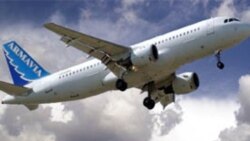By Tatevik Lazarian
Citing falling international fuel prices, Armenia’s national airline, Armavia, announced on Thursday a sizable reduction in its air fares widely seen as disproportionately high. The move followed a December 5 decision by the Argentine management of Zvartnots international airport to cut the price of aviation kerosene supplied to Armavia and other carriers flying to and from Yerevan by 30 percent.
“Because of the reduction in the aviation fuel prices, Armavia is lowering the prices of its tickets by between 8 and 31 percent, depending on distance of flights and the amount of fuel used,” Nana Avetisova, a spokeswoman for the private company, told RFE/RL. She said the price cut will apply to flights carried out from January 1.
Armavia currently flies to 22 cities in Europe, the former Soviet Union and the Middle East. It is owned by Mikhail Baghdasarov, a Russian citizen of Armenian descent who has extensive business interests in Armenia and is reputedly close to President Serzh Sarkisian.
Other, foreign carriers present in Armenia appear in no rush to follow Armavia’s example. An official at the Yerevan office of Russia’s Aeroflot said the company is unlikely to cuts its fares because fuel accounts for only 10 percent of the cost of its flights between Moscow and Yerevan.
“The airport has cut the fuel price, but that is not the only factor,” said Gagik Khanamirian. “The prices of other services haven’t changed.”
Representatives of another major Russian carrier, Sibir, as well as the British Mediterranean Airways and the Czech national airline CSA would not comment on their pricing policy, saying it is decided by their head offices.
Many Armenians have long felt that they pay too much for traveling by air. There was ample evidence of this sentiment at Zvartnots on Thursday. “Air tickets are expensive here compared to other countries,” said one man.
“Tickets bought in Yerevan are terribly expensive,” agreed a female passenger checking in for a charter flight to Egypt. “It costs much less to fly to Egypt from Moscow than from Yerevan.”
In a report released in early 2007, World Bank economists blamed the high cost of air travel to and from Armenia on the government’s protectionist policies and, in particular, “special privileges” enjoyed by Armavia. The government’s Civil Aviation Department is believed to restrict the entry of more foreign airlines in the local aviation market and keep air fares artificially high to help Armavia compete with the few other carriers.
The head of the department, Artyom Movsesian, defended this policy in April 2007. “It’s better to give [control of the market] to our carriers because they pay taxes here, while foreign companies don’t,” he argued. “This is also a matter of national security.”
The situation may well change after the signing earlier this week of an aviation agreement between Armenia and the European Union that allows any European airline to fly to the South Cacasus state. EU Transport Commissioner Antonio Tajani said all EU carriers will now have “non-discriminatory access to the air transport market between the EU and Armenia.”
In addition to the high fares, travelers also have to pay 10,000 drams ($32.5) every time they fly out of Armenia. Armavia’s Baghdasarov recently called for the abolition of the so-called “air tax” introduced in 1998, saying that it is unfair and “repels” tourists.
Vakhtang Mirumian, a senior official at the Armenian Finance Ministry, told RFE/RL that the government has discussed the matter and decided against scrapping the fixed duty. Mirumian said the government will only levy it from airlines, rather than passengers, starting from next March. The airlines are expected to add the tax to the price of their tickets, however.
According to the Zvartnots administration, some 706,800 people have left Armenia through its main international airport this year, meaning that the government has collected more than $23 million worth of “air tax” since January.
(Photolur photo)




